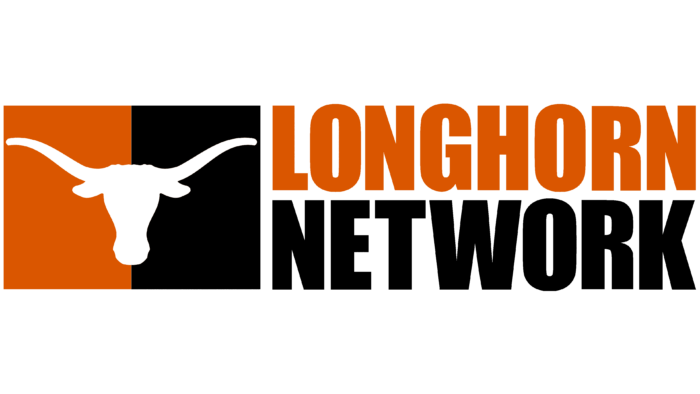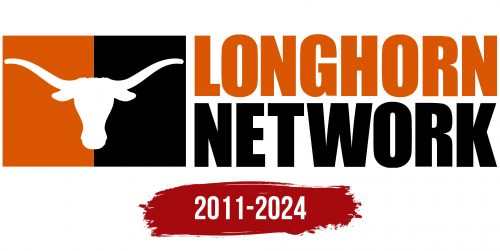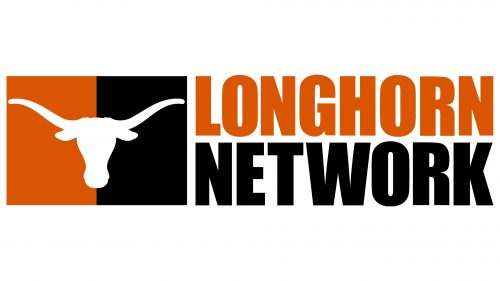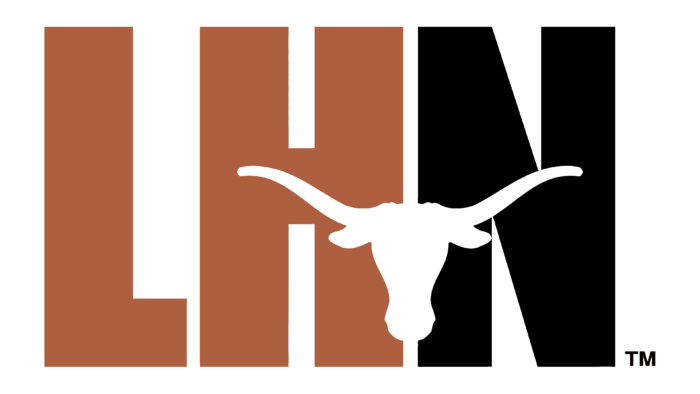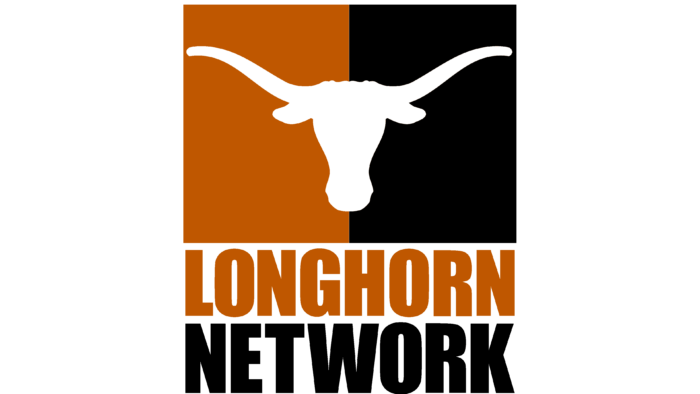The sports channel’s emblem shows competitions, defeats, and victories. The Longhorn Network logo demonstrates the strength and tenacity of the participating students. It shows a sign and variability of fate: today, some win, others lose, and tomorrow—on the contrary.
Longhorn: Brand overview
There are many sports-themed TV channels in the U.S., but the Longhorn Network stands out because of its unusual concept. It covers events at the University of Texas at Austin, including almost all soccer, volleyball, softball, baseball, and basketball games. Golf, rowing, tennis, athletics, and diving aren’t neglected either. The content is not limited to that, as cultural and academic programs, studio shows, and original series are aired.
The Longhorn Network was formally launched on August 26, 2011, as a collaboration between Learfield, ESPN Inc., and the University of Texas at Austin. This groundbreaking effort was the first of its kind, featuring a television channel dedicated solely to a single university and its athletic programs.
The concept for this dedicated sports channel arose from the University of Texas’s desire to increase its media presence and provide fans with exclusive content about the school’s athletic teams. ESPN saw an opportunity to expand its offerings, drawing on its experience developing niche sports networks.
Preparations for the channel’s launch spanned several years. In January 2011, the University of Texas and ESPN announced a 20-year, $300 million deal to create a 24-hour channel devoted to the university’s sports programming.
The network’s premiere generated a lot of excitement in the sports and media industries. The channel promised never-before-seen access to game and practice broadcasts, interviews with coaches and players, and documentaries about the history of athletics at the University of Texas.
However, the channel faced challenges in its early years. Distribution issues arose due to the reluctance of some major cable and satellite operators to include the channel in their packages. This limited fans’ access to content and put the project in financial jeopardy.
Despite these early setbacks, the network continued to grow. Over time, the station added more shows and formats, gradually expanding its programming. In addition to covering prominent sports like basketball and football, the channel also focused on the university’s lesser-known sports programs.
A pivotal moment in the channel’s history came when it expanded its availability by securing deals with various providers. By 2015, the channel was accessible to millions of households in Texas and beyond.
Creating original content has been a key part of the network’s strategy. The channel began producing documentaries highlighting significant moments in collegiate athletics history and profiles of legendary players and coaches at the University of Texas. These shows attracted a broader audience, including those interested in sports history and current fans.
2016, the network celebrated its fifth anniversary, marking a significant milestone. By this time, it had become a major player in the American collegiate athletics media landscape. The channel continued experimenting with different formats to adapt to its audience’s changing tastes and technological advancements.
Further changes to the channel model were made in 2018. The network began focusing more on its online presence, expanding its social media following, and enhancing its streaming capabilities. This allowed it to reach a younger audience and adapt to the growing trend of content consumption on mobile devices.
Despite global challenges in 2020 and 2021, the network continued to operate while adapting to the new circumstances. The channel expanded its online presence and produced more content that could be created remotely.
Throughout its existence, the network has demonstrated innovation in college sports broadcasting. It has enhanced the University of Texas’s reputation in the sports industry and provided fans exclusive access to their favorite teams.
The channel remains a unique example of a specialized sports network dedicated to a single university and continues to play an important role in the college sports media landscape. Its history illustrates how creativity and a commitment to high-quality content can result in a successful and enduring media project.
Meaning and History
What is Longhorn?
It is a joint project between ESPN and the Learfield IMG College marketing company. They have joined forces to help UT Austin realize its students’ athletic potential and showcase their accomplishments. The network broadcasts year-round and, even more so, around the clock. Operating 24/7, it is available through telecommunications, cable, and satellite providers. In addition, it cooperates with several major streaming services. Viewers can see exclusive events daily, such as shows with the university’s team coaches, press conferences, guest speakers, and various campus events. The content is geared toward those interested in UT Austin life or passionate about sports.
2011 – 2024
The Longhorn Network was launched in August 2011 and introduced in early April. That’s when fans learned what it was called and its visual symbol. The naming was predictable: The television project is named after university sports teams. And those, in turn, are named after a long-horned bull bred in Texas. It represents strength, power, and endurance.
The animal’s head is depicted on the official emblem of the Texas Longhorns athletics department. This particular graphic was the basis for the Longhorn Network logo. The designers made the silhouette white and moved it to the center of a rectangle divided into two blocks: dark orange (left) and black (right). The brand name written next to it is the same color. The massive sans-serif letters make it easy to read and immediately striking.
The chain has not changed its logo since 2011. The bull’s head, which is in full face, remains the logo’s centerpiece. It is depicted schematically, without detail. Only the outer contours are outlined: you can see the ears, the nose, and the widely spaced horns. The negative space, an empty area inside the connecting rectangles, forms the silhouette. The head is visually divided into two parts because the rectangles are painted differently. At the same time, both sides are perfectly symmetrical, just like the Texas Longhorns sports team logo.
The impersonal animal demonstrates the brand’s commitment to minimalism. At the same time, the formidable bull is one of the main symbols of the state where the university, whose life is illuminated by the Longhorn Network, is located. The emblem is used for different purposes: it is placed on the screen during the show’s broadcast and printed on various materials, including souvenirs.
Longhorn: Interesting Facts
The Longhorn Network (LHN) stands out in U.S. sports broadcasting, focusing entirely on the University of Texas at Austin’s athletics.
- University of Texas Spotlight: Unlike other sports networks that cover a variety of teams and sports, this channel is solely dedicated to the University of Texas, making it a unique venture in sports media.
- Launch Year: The network, launched on August 26, 2011, through a collaboration between the University of Texas at Austin, ESPN, and IMG College, marked a significant step in collegiate sports broadcasting.
- Broad Coverage: Although the channel is famous for football, it broadcasts various sports, including basketball, baseball, and more, as well as academic and cultural events at the university.
- Shaking Up Conferences: The creation of this network played a big role in college sports conference realignments in the early 2010s, raising concerns over revenue distribution among Big 12 Conference schools and leading to some schools’ departure.
- High School Sports Debate: Plans to show high school football games featuring top recruits initially sparked controversy over potential recruiting advantages for the University of Texas. The NCAA eventually ruled out such broadcasts.
- Financials: The deal to start this network was worth about $300 million over 20 years, showing ESPN’s significant investment in college sports broadcasting and the value of University of Texas athletics.
- Original Shows: Beyond live sports, the channel produces news, documentaries, and shows focused on University of Texas sports, providing detailed coverage of athletes and coaches.
- Viewing Hurdles: Initially, fans had trouble accessing the network due to disputes over fees and distribution with cable providers. Availability has since improved through agreements.
- Influence on Others: The success of this venture led other universities to consider similar initiatives. However, many have joined conference-wide networks like the Big Ten Network and SEC Network for even more revenue sharing.
- Tech Forward: The network uses advanced broadcast technology, including HD and digital streaming, to enhance viewers’ experience.
Font and Colors
The logo creators decided to experiment with typography and developed custom glyphs for the inscription. At the same time, the font is similar to Akkordeon Ten by Emtype Foundry. In both cases, the letters are bold and massive, elongated vertically. Only a few details differ: in Longhorn Network, for example, the gap inside the “R” has an oval shape, and the bottom of the “G” seems smoother due to the cut on the vertical stroke. The font helps draw viewers’ attention to the television brand name because both words are translated in upper case. The narrow letter spacing doesn’t impair the text’s readability.
The color Burnt Orange (#BF5700) was taken from the official palette of UT Austin’s athletic department. It ties the network and the Texas Longhorns together on an identity level. This shade is used for the rectangle’s left half and the lettering’s first line. Everything else is painted black except the white bull’s head, whose silhouette is formed by the negative space. This contrast makes the logo clear and stylish. There are also affinities with university teams: their main colors are orange and white, but in some cases, tiger coloring is used.
